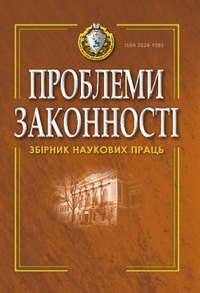Causation in Tort Law: Review of the “But For” Test
DOI:
https://doi.org/10.21564/2414-990x.147.174065Keywords:
causation, “but for” test, conditio sine qua non, tort lawAbstract
Causal connection between tortfeasor’s behavior and damage sustained by the plaintiff constitutes an inevitable precondition for liability in tort. The concept of causation is a matter of much debate in academic literature. In contrast, courts rarely provide exhaustive reasoning on the issue of causal nexus. That is so partly because the causal connection is often considered obvious or self-evident. Undoubtably there are many cases where causation is so evident that no one will question it. However there are also some factual situations where that is not the case. No one can effectively cope with difficult cases unless having established workable principles for the easy cases in the first place. The basic tool for analyzing causation in easy cases is the “but for” test. Notwithstanding the causation itself is of ontological nature the “but for” test is of linguistic nature. In fact it constitutes a question: would B have occurred, but for A? (where A is antecedent and B is consequent). The result of the “but for” test’s application depends on several choices. First, in reality the result is always caused by numerous factors. In contrast, the “but for” test tests only one antecedent. Therefore, this one factor has to be chosen (by a judge). Secondly, having chosen some factor judge still can choose the exact wording of that factor. Thirdly, although the consequent is always the damage sustained by the plaintiff, this damage can be put in words in numerous ways (from general outline to very specific description).
References
McInnes, M. (1996). Causation in Tort Law: Back to Basics at the Supreme Court of Canada. Alta. L. Rev., 35(4), 1013–1034.
Donska, L.D. (2006). Prychynnyi zviazok u tsyvilnomu pravi Ukrainy [Causal connection in civil law of Ukraine]. Extended abstract candidate’s thesis. Odesa [in Ukrainian].
Bogdanov, D.E. (2012). Spravedlivost i voprosy ustanovleniya prichinno-sledstvennoy svyazi v sudebnoy praktike [Equity and finding causation in judicial practice]. Rossiyskaya yustitsiya – Russian justice, 12, 56–59 [in Russian].
Bogdanov, D. (2011). Prichinno-sledstvennaya svyaz kak usloviye deliktnoy otvetstvennosti [Causal connection as a precondition of tort liability]. Khozyaystvo i pravo – Economic and Law, 8, 106–110 [in Russian].
Bolotova, H.D. (2015). Do pytannia prychynnoho zviazku u hospodarskykh sporakh pro vidshkoduvannia zbytkiv [On the issue of causal connection in commercial disputes about damages]. Ekonomika ta pravo – Economics and Law, 2(41), 53–56 [in Ukrainian].
Vavzhenchuk, S., Dovhopol, V. (2011). Mezhi rozuminnia yurydychnoi pryrody prychynnoho zviazku v tsyvilnomu pravi [The boundaries of understanding the legal nature of causation in civil law]. Pidpryiemnytstvo, hospodarstvo i pravo – Entrepreneurship, economy and law, 2, 13–15 [in Ukrainian].
Hapalo, S.Yu. (2008). Prychynnyi zviazok mizh protypravnoiu povedinkoiu porushnyka hospodarskoho zoboviazannia ta zbytkamy yak pidstava hospodarsko-pravovoi vidpovidalnosti [Causal link between the wrongful conduct of the wrongdoer and damages as a basis of economic legal liability]. Universytetski naukovi zapysky – University Scientific Notes, 1, 132–137 [in Ukrainian].
Korzun, S.A. (2008). Prichinno-sledstvennaya svyaz – neobkhodimoye usloviye otvetstvennosti vladeltsev transportnykh sredstv: voprosy teorii i sudebnoy praktiki [A causal relationship is a prerequisite for the responsibility of vehicle owners: theory and court practice.]. Rossiyskiy sudia – Russian Judge, 4. 26-27 [in Russian].
Kulitska, S.V. (2016). Osoblyvosti prychynnoho zviazku u zoboviazanniakh po vidshkoduvanniu (kompensatsii) shkody, zapodiianoi vnaslidok protypravnoi diialnosti / bezdiialnosti orhaniv sudovoi vlady [Peculiarities of causal connection in obligations for compensation (compensation) for damage caused as a result of illegal activity / inaction of judicial authorities]. Visnyk Odeskoho natsionalnoho universytetu. Seriia: Pravoznavstvo – Bulletin of the Odessa National University. Series: Jurisprudence, vol. 21, issue 1 (28), 59–67 [in Ukrainian].
Pendiaha, A.L. (2011). Znachennia prychynnoho zviazku yak pidstavy tsyvilno-pravovoi vidpovidalnosti [The meaning of causation as the basis of civil liability]. Ekonomika, finansy, pravo – Economics, finance, law, 4, 34–36 [in Ukrainian].
Prymak, V. (2014). Prychynno-naslidkovyi zviazok yak umova vidshkoduvannia moralnoi shkody kriz pryzmu vymoh spravedlyvosti, rozumnosti y dobrosovisnosti [Causal connection as a precondition for the compensation of moral harm through the prism of the requirements equity, good faith and reasonablity]. Yurydychna Ukraina – Legal Ukraine, 1, 25–30 [in Ukrainian].
Shevtsov, S.G. (2012). Usmotreniye i prichinno-sledstvennyye svyazi v grazhdanskom prave [Discretion and cause-effect relationships in civil law.]. Sovremennoye pravo: nauchno-prakticheskiy zhurnal – Modern law: scientific journal, 3, 78–81 [in Ukrainian].
Roziasnennia Vyshchoho arbitrazhnoho sudu Ukrainy N. 02-5/215 vid 01.04.94 r. «Pro deiaki pytannia praktyky vyrishennia sporiv, poviazanykh z vidshkoduvanniam shkody». [Clarification of the Supreme Arbitration Court of Ukraine No. 02-5/215 dated 01.04.94 “On Some Issues of the Practice of Dispute Settlement Related to Compensation for Harm”. URL: https://zakon.rada.gov.ua/laws/show/v_215800-94 [in Ukrainian].
Mill, J.S. (1882). A System Of Logic, Ratiocinative And Inductive. 8th ed. New York: Harper & Brothers, Publishers. URL: http://www.gutenberg.org/files/26495/26495-pdf.pdf.
Spohn, W. (2006). Causation: An Alternative. Brit. J. Phil. Sci., 57, 93–119.
Knutsen, Erik S. (2010). Clarifying Causation in Tort, Dalhousie L. J., 33, 153–187.
Matvieiev, H.K. (2008). Pidstavy tsyvilno-pravovoi vidpovidalnosti. Selected works. Kyiv: Ukraina, 20–263 [in Ukrainian].
Burlaka, I.V. (2016). Zoboviazannia z vidshkoduvannia shkody, zavdanoi bez vyny [Obligations to compensate for damage caused without fault]. Kharkiv: Pravo [in Ukrainian].
Pound, R. (1957). Causation. Yale Law Journal, 67(1), 1–18.
Wright, Richard W. (1985). Causation in Tort Law, Cal. L. Rev., 73, 1735–1828.
Downloads
Published
How to Cite
Issue
Section
License
Copyright (c) 2019 Богдан Петрович Карнаух

This work is licensed under a Creative Commons Attribution 4.0 International License.










